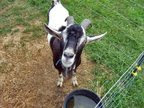Every goat-raiser should always be on the alert regarding their goat’s health. Preventive goat care is still the best defense against diseases that are expensive to treat or control.
Health issues are a daily occurrence in a farm.
Bad signs
Pay attention to goats that stay away from the main herd. Check if he is not eating at all and has an abnormal body posture (head hanging down, slow strained gait). Goats separate themselves from the herd only if they are about to give birth or, worse, is sick.
Goat droppings (feces) always show the state of health of the owner. If the droppings are clumping together, or if the goat is scouring, the signs could point to diarrhea. If they are very hard, there could also be another thing wrong.
Then there is the goat that is lagging behind and cannot keep up with the herd. Are the goat’s feet and legs swollen?
Is there an animal in your herd that has suddenly and inexplicably lost weight?
Have you noticed any signs of swelling underneath the chin? It could point out to internal parasites in his system. If the swelling is in the throat, it might be goiter.
Do you have a goat with an abnormal gait? Is it staggering, limping? You may have a case of tetanus.
Are the fur of your animals dull and rough? If they are, it could mean some nutritional deficiencies or some other underlying disease.
Are there fluid discharges (pus, mucus, blood) from any of the body orifices of your animals? Fluid discharges are usually results of the ongoing battle of the body and some internal illness.
Some identified diseases
Since your animals are free-ranging, they can collect parasites. These vermin feed on the animal’s system that hinders growth, degrades health, and sometimes can be fatal.
Coccidia are intestinal worms that slow down or stop the growth of kids. It takes time to notice this parasite. Young kids are at highest risk.
Caprine Arthritis Encephalitis Syndrome (CAE) is caused by a virus and is transmitted from adults to young kids. Symptoms include a weakness in the rear legs that gradually lose muscle strength and kills.
Adults have swollen joints, mostly in the knees. The afflicted goat never recovers from the arthritis.
Mastitis is an inflammation caused by bacteria. There is discoloration of the udder tissues and the milk is abnormal.
Hygienic practices during milking are the best defense. (Wash your hands and the udders before and after milking, and during transfer from doe to doe.)
Ketosis (pregnancy toxemia) attacks pregnant does. This disease is actually triggered by the sudden demand of the body for extra energy (caused by the developing fetus) and the inability of the doe to eat enough to provide this.
The doe’s body will then metabolize her own store of fat, producing ketone bodies. The doe becomes weak, lose muscle control and balance, and could die.
For prevention, do not allow the doe to get fat in pregnancy and provide an extra pound or two of grains in the last month.
As goat raisers, it is good policy to be always on health alert. Even ticks can become a major pest. Goat care is not that difficult, but vigilance is a good practice.






No comments:
Post a Comment